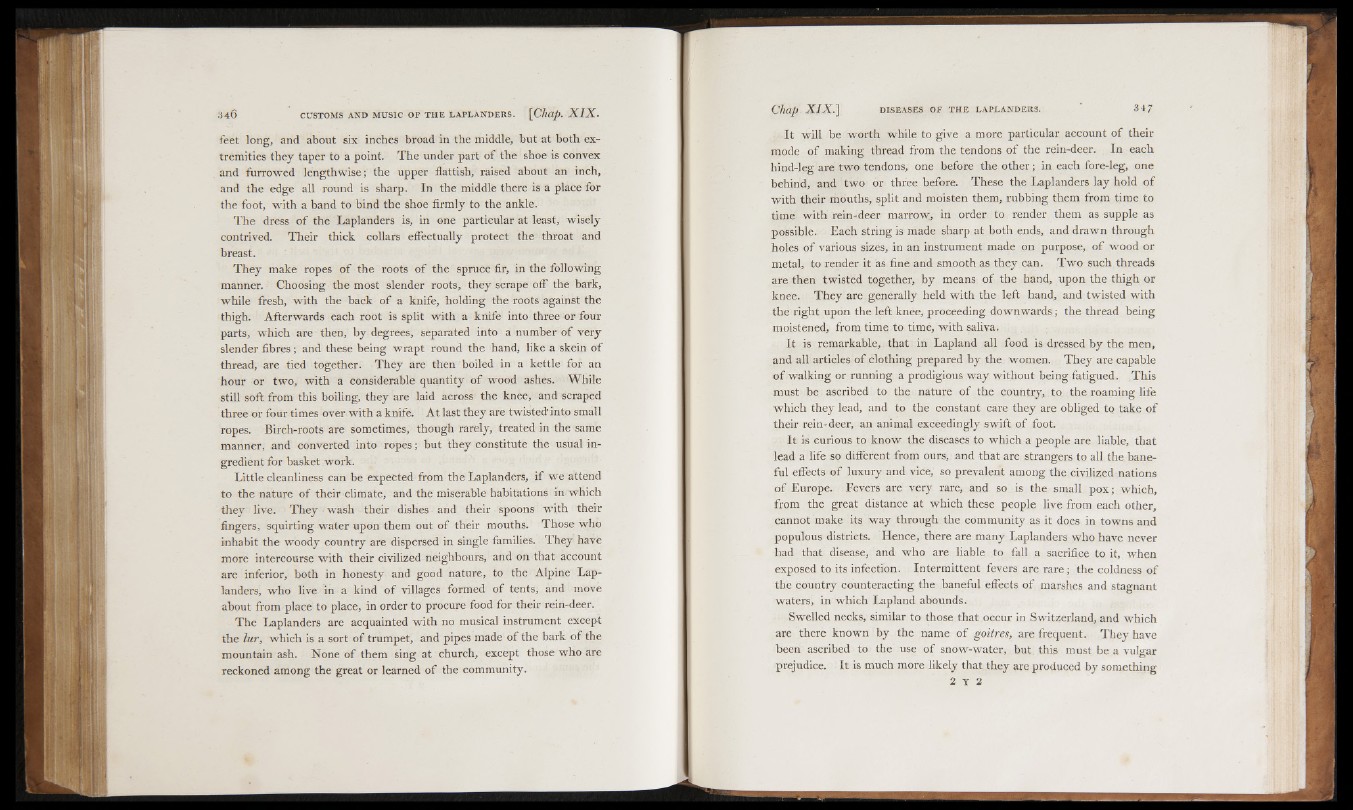
feet long, and about six inches broad in the middle, but at both extremities
they taper to a point. The under part of the shoe is convex
and furrowed lengthwise; the upper flattish, raised about an inch,
and the edge all round is sharp. In the middle there is a place for
the foot, with a band to bind the shoe firmly to the ankle.
The dress of the Laplanders is, in one particular at least, wisely
contrived. Their thick collars effectually protect the throat and
breast.
They make ropes o f the roots of the spruce fir, in the following
manner. Choosing the most slender roots, they scrape off the bark,
while fresh, with the back of a knife, holding the roots against the
thigh. Afterwards each root is split with a knife into three or four
parts, which are then, by degrees, separated into a number of very
slender fibres; and these being wrapt round the hand, like a skein of
thread, are tied together. They are then boiled in a kettle for an
hour or two, with a considerable quantity of wood ashes. While
still soft from this boiling, they are laid across the knee, and scraped
three or four times over with a knife. At last they are twisted’into small
ropes. Birch-roots are sometimes, though rarely, treated in the same
manner, and converted into ropes; but they constitute the usual ingredient
for basket work.
Little cleanliness can be expected from the Laplanders, i f we attend
to the nature of their climate, and the miserable habitations in which
they live. They wash their dishes and their spoons With their
fingers, squirting water upon them out of their mouths. Those who
inhabit the woody country are dispersed in single families. They have
more intercourse with their civilized neighbours, and on that account
are inferior, both in honesty and good nature, to the Alpine Laplanders,
who live in a kind of villages formed of tents, and move
about from place to place, in order to procure food for their rein-deer.
The Laplanders are acquainted with no musical instrument except
the lur, which is a sort of trumpet, and pipes made o f the bark of the
mountain ash. None of them sing at church, except those who are
reckoned among the great or learned of the community.
It will be worth while to give a more particular account of their
mode o f making thread from the tendons o f the rein-deer. In each
hind-leg are two tendons, one before the other; in each fore-leg, one
behind, and two or three before. These the Laplanders lay hold of
with their mouths, split and moisten them, rubbing them from time to
time with rein-deer marrow, in order to render them as supple as
possible. Each string is made sharp at both ends, and drawn through
holes o f various sizes, in an instrument made on purpose, o f wood or
metal, to render it as fine and smooth as they can. Two such threads
are then twisted together, by means of the hand, upon the thigh or
knee. They are generally held with the left hand, and twisted with
the right upon the left knee, proceeding downwards; the thread being
moistened, from time to time, with saliva.
It is remarkable, that in Lapland all food is dressed by the men,
and all articles o f clothing prepared by the women. They are capable
of walking or running a prodigious way without being fatigued. This
must be ascribed to the nature of the country, to the roaming life
which they lead, and to the constant care they are obliged to take of
their rein-deer, an animal exceedingly swift o f foot.
It is curious to know the diseases to which a people are liable, that
lead a life so different from ours, and that are strangers to all the baneful
effects o f luxury and vice, so prevalent among the civilized nations
of Europe. Fevers are very rare, and so is the small pox; which,
from the great distance at which these people live from each other,
cannot make its way through the community as it does in towns and
populous districts. Hence, there are many Laplanders who have never
had that disease, and who are liable to fall a sacrifice to it, when
exposed to its infection. Intermittent fevers are rare; the coldness of
the country counteracting the baneful effects o f marshes and stagnant
waters, in which Lapland abounds.
Swelled necks, similar to those that occur in Switzerland, and which
are there known by the name of goitres, are frequent. They have
been ascribed to the use o f snow-water, but this must be a vulgar
prejudice. It is much more likely that they are produced by something
2 y 2